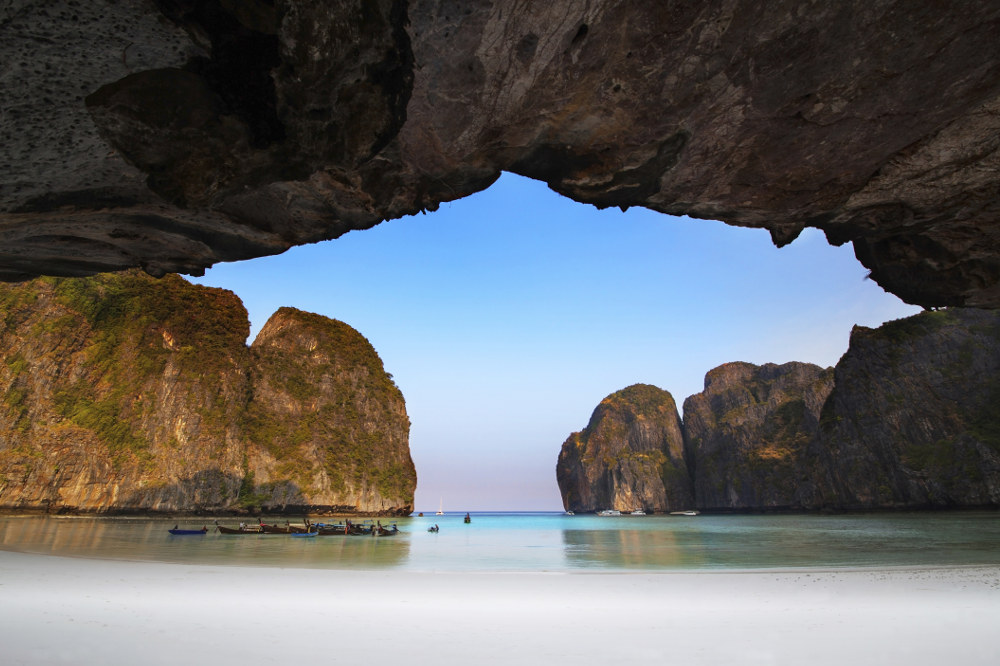Thailand’s Phi Phi islands are by no means uncharted territory. Located off the coast of Krabi in southern Thailand, the archipelago is best known for its largest two islands, Phi Phi Don and Phi Phi Leh.
Gushed about in guidebooks and beloved by the backpacker set, these islands are famous for their sandy beaches, warm waters and towering limestone cliffs. There is a drawback, however: thousands of tourists wander their shores every day, particularly during the high season from November to March.
So, I almost couldn't believe my eyes when I was woken by the rising sun to see the most famous of the Phi Phi beaches completely empty. After spending a few days on Phi Phi Don, the larger of the two, I quickly grew tired of navigating the island’s countless resorts, restaurants and souvenir stands among the constant crush of other tourists.
I was easily swayed when I heard about the opportunity to spend a night docked at uninhabited Phi Phi Leh. Best known for Maya Bay, the location of Leonardo DiCaprio's personal paradise in the 2000 film The Beach, the island has been a top day-trip destination ever since the movie was released.
Dozens of speedboats, ferries and traditional long-tail boats depart from Krabi, Phuket and Phi Phi Don each day to Maya Bay, filled with travellers anxious to experience the wild, uncharted island seen in the film. These crowds make it difficult to imagine Phi Phi Leh as a deserted paradise.
The longest stretch of sand on Maya Bay is no longer than 200 metres across, so sunbathers often lie shoulder-to-shoulder while snorkellers bump into each other as they attempt to swim around the docked boats.
Hop across the Gulf of Thailand: Song Saa Private Island
Discover more magical beaches: Where To Stay In French Polynesia
As a designated national park, development and visitation to Maya Bay remains under the jurisdiction of the Thai government, which began enforcing a ban on all overnight visitors in 2012. Only one tour operator, Maya Bay Tours, now offers guests the unique opportunity to see the island after sunset on an overnight excursion, and I was lucky enough to snag a coveted spot on one of its high-season tours.
Embarking on the tour boat at the Phi Phi Don dock, I was pleased to see the group was small, only about 30 fellow travellers hailing from all over the world. After a scenic 20-minute ride, the boat cruised into the entrance of Maya Bay.
The sight of pale yellow sand and lush palm trees framed by jagged cliffs hushed the group, aside from the sound of clicking cameras. Since we’d arrived in the late afternoon the shore was not short on crowds, but with no towering resorts in the distance or hawkers pushing souvenirs and snacks, the beach still appeared as magical as it did in its film debut.
As a blanket of darkness slipped over the sky, the last boats departed and it was finally time to truly explore. Walking along the cool, silky sand with only the dim light of our boat in the distance to illuminate the beach, it was easy to imagine we were the first people to ever visit the island.
Aside from the waves lapping at the shore, it was almost hauntingly quiet, a welcome relief from the thumping bass that I’d grown accustomed to during my evenings on Phi Phi Don.
To get a real feel for the island at night, our guides took us on a tour through its unmarked, sandy paths. Flashlight in hand, I tentatively followed them through the forested darkness, thick with bushes and trees creating spooky shadows.
One of the guides, Coco, proved to be an expert at spotting the island's rarest inhabitants: the tree-climbing crab. Much larger than the tiny hermit and sand crabs typically seen on Thai beaches, these crabs have powerful pincers that give them the unique ability to scale to the top of trees.
Coco held one up to the group's squealing delight, assuring us that, despite being about as big as our faces, these crabs are very afraid of humans and would do us no harm. They are the largest creatures on the island; while it is rich with flora, it does not support much wildlife.
Visitors are not allowed to sleep on the island so we headed back to the boat to turn in for the night, only to find one more surprise in store: a midnight swim. The afternoon's clear blue waters were now a velvety black, easily disguising any dangers lurking beneath.
Luckily, instead of predators, the sea was filled with bioluminescent plankton. Microscopic in size, the plankton flare brightly when disturbed, a chemical reaction much like the one seen in fireflies. Several unpredictable environmental factors have to align for the plankton to be seen, so we were extremely lucky to see a magical light show that rivalled the brightness of the stars above.
Sleeping on the boat was not an exercise in luxury, with just a foam mattress, sleeping bag and small pillow provided but the gentle rocking of the boat and cool breeze quickly lulled me to sleep.
The next morning's sunrise allowed one more visit to the empty beach before the tour boats made their unwelcome return. After a final swim at nearby Pileh Bay, we headed back to the hustle of Phi Phi Don. I closed my eyes, daydreaming already about my night on the deserted island.
This article was from BBC and was legally licensed through the NewsCred publisher network.













